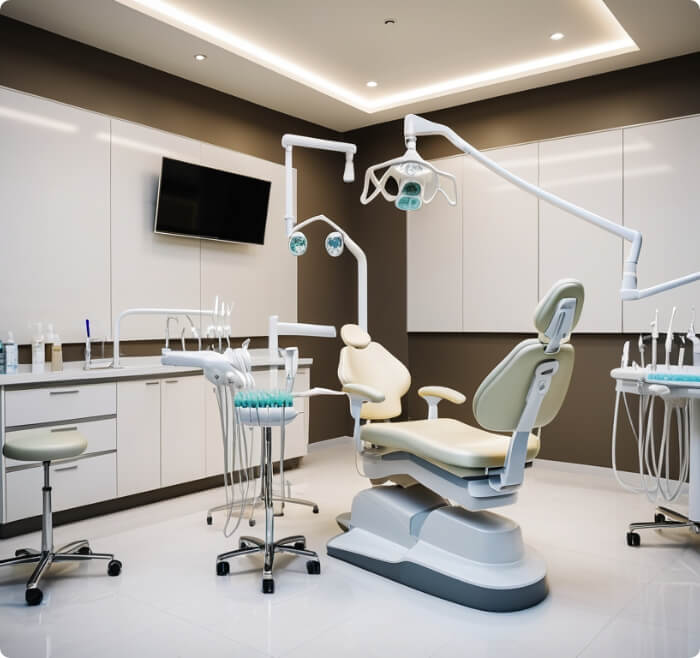How Long Do Braces Take to Work?
Dates: 2025-03-24
View:
When it comes to orthodontic treatment, one of the most common questions patients have is: How long do braces take to work? Whether you're considering braces or are already undergoing treatment, understanding the timeline can help you set realistic expectations for the journey ahead.
1. What Is the Typical Duration of Braces Treatment?
On average, most people wear braces for 18 to 24 months. This timeframe varies depending on several factors, including the complexity of your dental issues, your age, and how well you follow your orthodontist's instructions.
2. Factors That Affect How Long Braces Take
Several factors influence how long you will need to wear braces. These include:
a. The Complexity of Your Case
The primary factor that determines how long you'll need braces is the complexity of your orthodontic issues. If you're simply dealing with mild misalignment or crowding, your treatment time may be relatively short. However, if you're correcting significant bite issues (like overbite, underbite, or crossbite) or significant teeth gaps, the treatment time will likely be longer.
b. Your Age
Age plays an important role in how quickly your teeth move. Younger patients, especially those in their teenage years, often experience faster results because their bones are still growing and more adaptable to change. Adults, on the other hand, may experience slower progress due to the fact that their bones are denser and less responsive to orthodontic movement.
c. Type of Braces Used
The type of braces you get can also impact the treatment time. Traditional metal braces, which are still the most commonly used, tend to take the longest to achieve results. However, newer options like Invisalign or clear braces might offer slightly faster results in certain cases due to their design and how they apply pressure to the teeth.
d. Treatment Compliance
How well you follow your orthodontist’s instructions can significantly affect your treatment time. Wearing rubber bands, avoiding certain foods, and attending scheduled check-ups are crucial to ensuring the braces work as efficiently as possible. Failure to adhere to these guidelines could prolong your treatment.
3. Stages of Braces Treatment: What to Expect
Braces treatment typically occurs in phases. Here's a breakdown of what to expect at each stage:
a. The Consultation Phase
Before you get braces, you'll have a consultation with an orthodontist. During this visit, your orthodontist will assess your teeth, take X-rays, and create a treatment plan. This phase usually takes 1 to 2 weeks and helps determine how long your treatment will take.
b. The Active Treatment Phase
The active phase is when the braces are applied and start working to shift your teeth into the desired position. This phase typically lasts the longest — 12 to 24 months — depending on your specific case.
c. The Retention Phase
Once your braces are removed, you will enter the retention phase, which is essential for maintaining your new smile. You’ll likely need to wear a retainer for a few months to a few years, depending on your orthodontist’s recommendation. In some cases, retainers are worn for life to keep teeth from shifting back.
4. Can You Speed Up Your Braces Treatment?
While the duration of braces treatment depends on several factors, there are a few things you can do to ensure your treatment progresses smoothly:
a. Follow Your Orthodontist's Instructions
This may seem obvious, but following your orthodontist’s advice is key to ensuring your braces work effectively and efficiently. Missing appointments, not wearing your rubber bands, or eating hard, sticky foods can delay progress.
b. Consider Accelerated Orthodontic Options
Some patients may be candidates for accelerated orthodontic treatments, which use technologies like AcceleDent or propel to stimulate faster tooth movement. These treatments can shorten the overall treatment time, but they may not be suitable for everyone, so it’s important to consult with your orthodontist to see if they’re right for you.
c. Maintain Excellent Oral Hygiene
Keeping your teeth and gums healthy during braces treatment is critical. Braces can trap food and bacteria, which may lead to cavities or gum disease if not properly managed. Brush and floss regularly, and visit your dentist for cleanings as recommended.
5. Can Braces Be Removed Early?
In most cases, braces cannot be removed early unless your teeth have reached the desired alignment. While you may feel like your treatment is taking too long, it’s important to follow the plan set by your orthodontist to ensure the best possible results. Premature removal of braces can lead to relapse, where your teeth shift back to their original positions.
6. What Happens After Your Braces Are Removed?
Once your braces are removed, you’ll enter the retention phase, during which time you’ll need to wear a retainer to prevent your teeth from shifting. This phase is just as important as the active treatment phase, so be sure to follow your orthodontist’s instructions to maintain your straightened smile.
Conclusion: How Long Do Braces Take to Work?
In summary, the typical duration for braces treatment ranges from 18 to 24 months, though it can be shorter or longer depending on your specific case. Factors like the complexity of your dental issues, age, and adherence to your treatment plan all contribute to how long it takes for braces to work.
If you're considering braces, be sure to consult with an orthodontist who can provide you with a personalized treatment plan and timeline. By following your orthodontist’s instructions and maintaining good oral hygiene, you can ensure the process goes as smoothly and quickly as possible.
If you're ready to start your journey toward a straighter smile, schedule a consultation with an orthodontist today and take the first step towards a more confident you!
1. What Is the Typical Duration of Braces Treatment?
On average, most people wear braces for 18 to 24 months. This timeframe varies depending on several factors, including the complexity of your dental issues, your age, and how well you follow your orthodontist's instructions.
2. Factors That Affect How Long Braces Take
Several factors influence how long you will need to wear braces. These include:
a. The Complexity of Your Case
The primary factor that determines how long you'll need braces is the complexity of your orthodontic issues. If you're simply dealing with mild misalignment or crowding, your treatment time may be relatively short. However, if you're correcting significant bite issues (like overbite, underbite, or crossbite) or significant teeth gaps, the treatment time will likely be longer.
b. Your Age
Age plays an important role in how quickly your teeth move. Younger patients, especially those in their teenage years, often experience faster results because their bones are still growing and more adaptable to change. Adults, on the other hand, may experience slower progress due to the fact that their bones are denser and less responsive to orthodontic movement.
c. Type of Braces Used
The type of braces you get can also impact the treatment time. Traditional metal braces, which are still the most commonly used, tend to take the longest to achieve results. However, newer options like Invisalign or clear braces might offer slightly faster results in certain cases due to their design and how they apply pressure to the teeth.
d. Treatment Compliance
How well you follow your orthodontist’s instructions can significantly affect your treatment time. Wearing rubber bands, avoiding certain foods, and attending scheduled check-ups are crucial to ensuring the braces work as efficiently as possible. Failure to adhere to these guidelines could prolong your treatment.
3. Stages of Braces Treatment: What to Expect
Braces treatment typically occurs in phases. Here's a breakdown of what to expect at each stage:
a. The Consultation Phase
Before you get braces, you'll have a consultation with an orthodontist. During this visit, your orthodontist will assess your teeth, take X-rays, and create a treatment plan. This phase usually takes 1 to 2 weeks and helps determine how long your treatment will take.
b. The Active Treatment Phase
The active phase is when the braces are applied and start working to shift your teeth into the desired position. This phase typically lasts the longest — 12 to 24 months — depending on your specific case.
c. The Retention Phase
Once your braces are removed, you will enter the retention phase, which is essential for maintaining your new smile. You’ll likely need to wear a retainer for a few months to a few years, depending on your orthodontist’s recommendation. In some cases, retainers are worn for life to keep teeth from shifting back.
4. Can You Speed Up Your Braces Treatment?
While the duration of braces treatment depends on several factors, there are a few things you can do to ensure your treatment progresses smoothly:
a. Follow Your Orthodontist's Instructions
This may seem obvious, but following your orthodontist’s advice is key to ensuring your braces work effectively and efficiently. Missing appointments, not wearing your rubber bands, or eating hard, sticky foods can delay progress.
b. Consider Accelerated Orthodontic Options
Some patients may be candidates for accelerated orthodontic treatments, which use technologies like AcceleDent or propel to stimulate faster tooth movement. These treatments can shorten the overall treatment time, but they may not be suitable for everyone, so it’s important to consult with your orthodontist to see if they’re right for you.
c. Maintain Excellent Oral Hygiene
Keeping your teeth and gums healthy during braces treatment is critical. Braces can trap food and bacteria, which may lead to cavities or gum disease if not properly managed. Brush and floss regularly, and visit your dentist for cleanings as recommended.
5. Can Braces Be Removed Early?
In most cases, braces cannot be removed early unless your teeth have reached the desired alignment. While you may feel like your treatment is taking too long, it’s important to follow the plan set by your orthodontist to ensure the best possible results. Premature removal of braces can lead to relapse, where your teeth shift back to their original positions.
6. What Happens After Your Braces Are Removed?
Once your braces are removed, you’ll enter the retention phase, during which time you’ll need to wear a retainer to prevent your teeth from shifting. This phase is just as important as the active treatment phase, so be sure to follow your orthodontist’s instructions to maintain your straightened smile.
Conclusion: How Long Do Braces Take to Work?
In summary, the typical duration for braces treatment ranges from 18 to 24 months, though it can be shorter or longer depending on your specific case. Factors like the complexity of your dental issues, age, and adherence to your treatment plan all contribute to how long it takes for braces to work.
If you're considering braces, be sure to consult with an orthodontist who can provide you with a personalized treatment plan and timeline. By following your orthodontist’s instructions and maintaining good oral hygiene, you can ensure the process goes as smoothly and quickly as possible.
If you're ready to start your journey toward a straighter smile, schedule a consultation with an orthodontist today and take the first step towards a more confident you!
Last One:
Top Tips for Maintaining Oral Health
Next Article:
Back to list
Get A Quote
Connect With Us For Dental Equipment Needs
Send Us Your Request And We Will Get Back To You As Soon As Possible.




